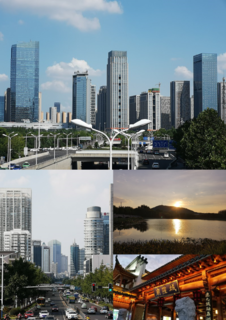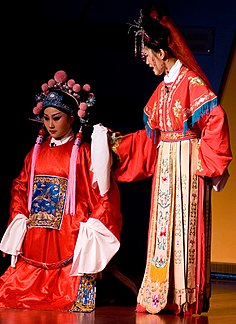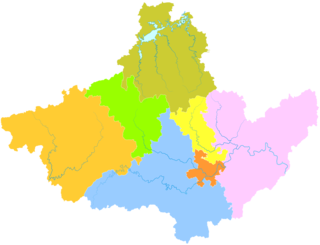Huiju (Chinese :徽剧), or "Anhui opera", is a variety of Chinese opera from the east-central province of Anhui, China, and was formerly also popular in neighboring Zhejiang. It is named for the historical region of Huizhou (now the city of Huangshan, Anhui), where it originated. It has existed for over 300 years.

Chinese is a group of related, but in many cases not mutually intelligible, language varieties, forming the Sinitic branch of the Sino-Tibetan language family. Chinese is spoken by the ethnic Chinese majority and many minority ethnic groups in China. About 1.2 billion people speak some form of Chinese as their first language.

Traditional Chinese opera, or Xiqu, is a form of musical theatre in China with roots going back to the early periods in China. It is an amalgamation of various art forms that existed in ancient China, and evolved gradually over more than a thousand years, reaching its mature form in the 13th century during the Song dynasty (960–1279). Early forms of Chinese theater are simple, but over time they incorporated various art forms, such as music, song and dance, martial arts, acrobatics, costume and make-up art, as well as literary art forms to become traditional Chinese opera.

Anhui is a province of the People's Republic of China located in the eastern region of the country. The province is located across the basins of the Yangtze River and the Huai River, bordering Jiangsu to the east, Zhejiang to the southeast, Jiangxi to the south, Hubei to the southwest, Henan to the northwest, and Shandong for a short section in the north.
Huiju was introduced to Beijing during the Qianlong Emperor's eightieth birthday celebrations, and was influential in being a precursor of Beijing opera. [1]

Beijing, formerly romanized as Peking, is the capital of the People's Republic of China, the world's third most populous city proper, and most populous capital city. The city, located in northern China, is governed as a municipality under the direct administration of central government with 16 urban, suburban, and rural districts. Beijing Municipality is surrounded by Hebei Province with the exception of neighboring Tianjin Municipality to the southeast; together the three divisions form the Jingjinji metropolitan region and the national capital region of China.

The Qianlong Emperor was the sixth emperor of the Manchu-led Qing dynasty, and the fourth Qing emperor to rule over China proper. Born Hongli, the fourth son of the Yongzheng Emperor, he reigned officially from 11 October 1735 to 8 February 1796. On 8 February, he abdicated in favour of his son, the Jiaqing Emperor—a filial act in order not to reign longer than his grandfather, the illustrious Kangxi Emperor. Despite his retirement, however, he retained ultimate power as the Emperor Emeritus until his death in 1799; he thus was one of the longest-reigning de facto rulers in the history of the world, and dying at the age of 87, one of the longest-lived. As a capable and cultured ruler inheriting a thriving empire, during his long reign the Qing Empire reached its most splendid and prosperous era, boasting a large population and economy. As a military leader, he led military campaigns expanding the dynastic territory to the largest extent by conquering and sometimes destroying Central Asian kingdoms. This turned around in his late years: the Qing empire began to decline with corruption and wastefulness in his court and a stagnating civil society.
The most prominent Huiju troupe is the Huiju Opera Troupe of Anhui Province, which was established in 1956 and is based in the city of Hefei. [2]

Hefei is the capital and largest city of Anhui Province, People's Republic of China. A prefecture-level city, it is the political, economic, and cultural center of Anhui. Located in the central portion of the province, it borders Huainan to the north, Chuzhou to the northeast, Wuhu to the southeast, Tongling to the south, Anqing to the southwest and Lu'an to the west.












